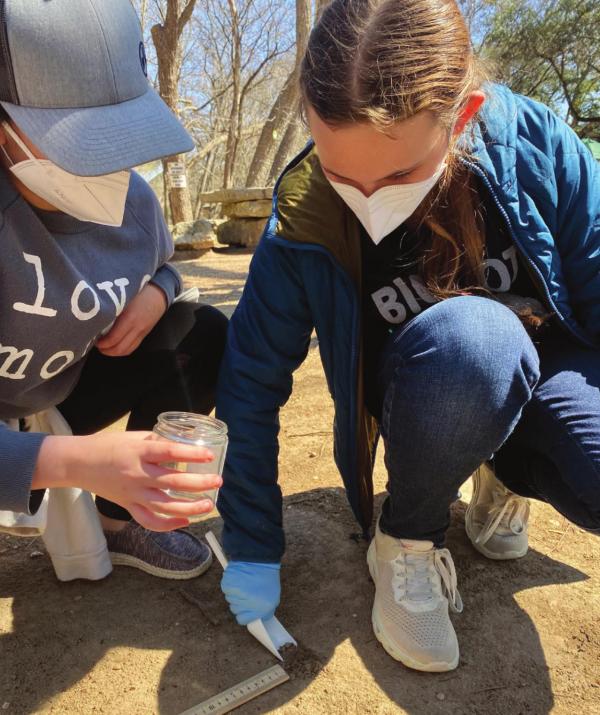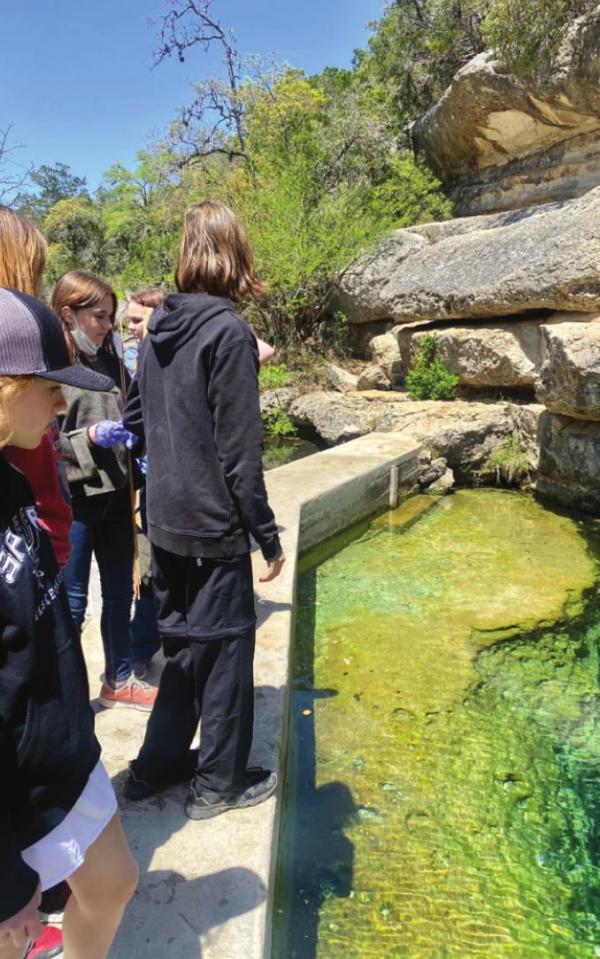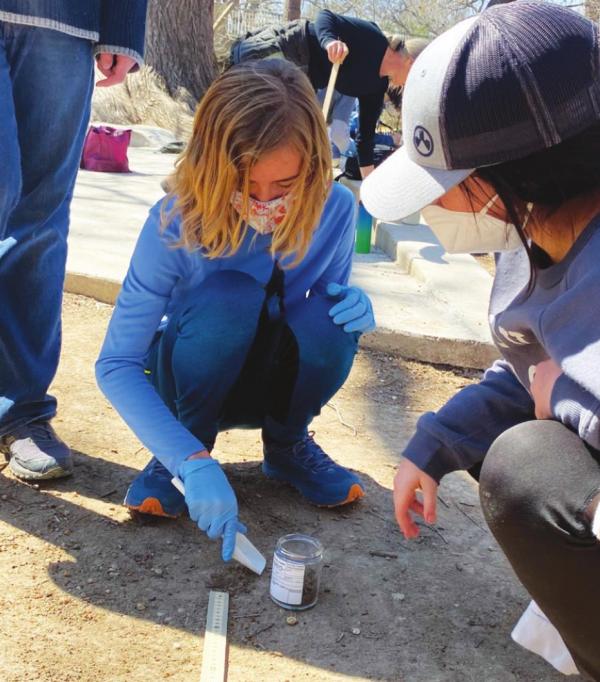Raising citizen scientists for the Valley
Lots of kids find swimming in cool water a great way to enjoy Blue Hole Park. Some kids find analyzing Blue Hole water is pretty cool, too.
Blanco River Academy’s students are learning a new way to experience the park, and doing something useful for the future of Wimberley Valley.
“We’re taking water and soil samples in different locations to see what kind of things are happening by the water or the road or in different areas,” said Adeline Yeary, a 12-year-old 7th grader.
As the first-ever middle school students to be part of a Texas A&M Citizen Scientist program – usually work for adults – the BRAc students are not just studying the environment; they are also learning how to interpret and protect it.
Having a good time outdoors is a bonus. “It’s a fun learning experience,” said 8th grader Maggie Kimbell-Jack, 13.
Citizen science efforts can provide valuable data for the community. While many such endeavors have occurred in other parts of the state, this is the first Hill Country-focused effort of its kind to date. Results are studied and compiled, not just for a current analysis of environmental conditions in Wimberley Valley, but for future comparisons to our present time, and with other locations.
“The students are using EPA (Environmental Protection Agency) approved field technology,” said Dr. Garett Sansom of Texas A&M University Superfund Research Center and School of Public Health. Sansom is training the students in the program, along with BRAc’s Environmental Studies teacher Jamie Kinscherff. “The students test for the presence of heavy metals in the water, or fine particulates that might be in the air, as well as off-gassing (the airborne release of a chemical) from vehicles and other sources.”
Using sophisticated field equipment, the students are able to make their own water readings immediately after collecting samples. The soil samples are sent to the Texas A&M School of Public Health laboratory, where Sansom analyzes them for contaminants such as lead, arsenic or mercury.
“These are the youngest kids I have ever had doing Citizen Science training,” said Sansom, whose son Benjamin is now an 8th grader at BRAc. “Typically, we do it with fully-adult community members or high school groups, but this is the first time with middle school individuals.”
All of the school’s classes (currently 5th-8th grade) are involved in the program, with 7th and 8th graders doing most of the collecting so far. Concern about their youth and their interest in the project was quickly dispelled, said Kinscherff. “When they learned that they were taking the baseline documentation of the soil, water and air, they were very enthusiastic. Becoming citizen scientists is intriguing to them. They feel like they are doing something important. And they are.”
Being hands on is an essential factor in the training, and begins almost immediately. “The first time, we went with Jamie and Garett,” said Maggie. “Garett walked us through the steps and we watched. Then he would have some of us do it with him so we could learn.
“The next time we went down, we did it all on our own.”
That was exciting for 8th grader Wiley Week, age 13. “We did that whole process. They told us where to (sample) and sent a group of three of us. One of us did the water and the other two did the soil.”
In addition to Blue Hole, students sample at other locations, including – so far - Jacob’s Well and the water near Cypress Creek Bridge downtown. More locations will be added when the delayed air quality equipment arrives.
“At Cypress Creek Bridge we took samples, one upstream and one downstream, to see how the water changes from things like bats under the bridge,” said Maggie. The bats poop into the water so we want to see how that changes the water and soil downstream.”
Blanco River Academy students are very familiar with Blue Hole. The small non-profit Wimberley Valley school, grades 5th-8th, is on Old Kyle Road, right outside Blue Hole’s entrance. Students are in the park for classes and field trips as part of BRAc’s focus as an environmental stewardship school.
The Citizen Scientist program and its equipment are costly, a factor for a small school, but the school’s environmental focus helped get a grant from the Texas A&M University Superfund Research Center (SRC), which is funded by the National Institute of Environmental Health Sciences (NIEHS).
“We are very privileged to be the only middle school in the country to have received this grant so far,” said Kinscherff. “We also received the grant for next semester, and hope this program will be an ongoing thing.”
That is key to success for both the school and the Citizen Science program; to obtain consistent, verifiable data over an extended time, which will be stored and used for comparison year after year. The students seem especially aware of and fascinated by that aspect of the project.
“It’s so we can see how our world is evolving,” Adeline said. “If we had taken these samples 30 years ago it would have been much different, because there has been much increase in cars and herbicides, stuff like that.”
Added Maggie, “Thirty years from now, 20 years, 10 years, the world is going to be different then, too. If we continue doing this, we can see how it’s changed. If it’s a good way, a bad way, or stayed the same.”
Citizen science and citizen scientist are relatively modern umbrella terms for an ancient practice: research done with scientific principles and methods by non-professional scientists. Think of Benjamin Franklin, using rods and kites to study electricity during storms.
The terms now have many very specific applications. Science and educational organizations all over the world utilize Citizen Science programs as an aide to advancing knowledge. One local example, sponsored by The Meadows Center for Water and the Environment at Texas State, is the Texas Stream Team. In that statewide citizen scientist effort, more than 1,400 volunteers – including many in Hays County - regularly gather information on the health of Texas waterways at more than 400 sites.
“With the reality of finite resources,” said Sansom, “we (scientists) can’t be everywhere and running the kind of analysis we want to. But citizen scientists can (for example) collect little critters out of streams and rivers. If they don’t find certain species, that may indicate there is an environmental issue there. Then scientists can come in and investigate.”
The participation of Blanco River Academy students has the potential to show that kids in their early teens can aid this crucial gathering of knowledge. That was an important consideration in adding the program to BRAc’s curriculum, said Head of School Kristie Kimbell, PhD.
“They are going to gather this pot of data that someone can use down the road,” she said. “We will be able to compare these findings to next year’s findings. We all know the Wimberley Valley is growing. What we don’t know yet is what all that impact will look like.” In addition, Kimbell felt the program fit in perfectly with the school’s aims, and its type of students.
“These are students for whom non-traditional learning methods are better,” Kimbell said. “Because of our small numbers, we can have differentiated, individualized learning. We use traditional methods, but we also love to get our hands dirty, both figuratively and literally.
“In this Citizen Science program, the kids are getting outside, which is huge. They are learning how to do it with their hands, not out of a book. It’s experiential learning; there is no better way to learn. And it gives them a sense of purpose. They feel like they are giving back. They are growing an understanding of what is important in protecting our water and soil and air, in the present and long term.”
At the same time, Kimbell hopes the program opens up new ideas and vistas to the maturing students, who realize they are nearing crucial decisions.
“This is a very influential age,” said Adeline. “You start thinking about what you want to do as an adult, that is not, like, just fairytale things. It’s important in a kid’s life to learn about what is going on in our environment, and how we can help.”




